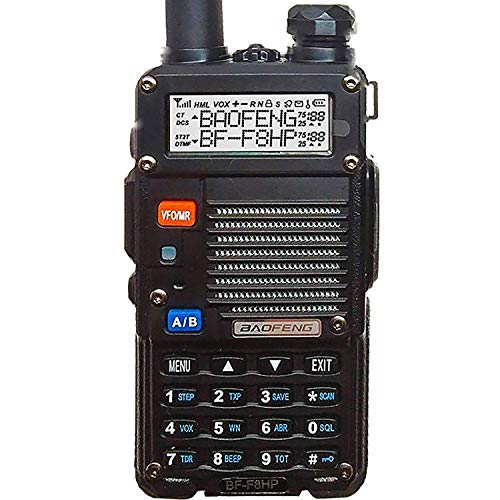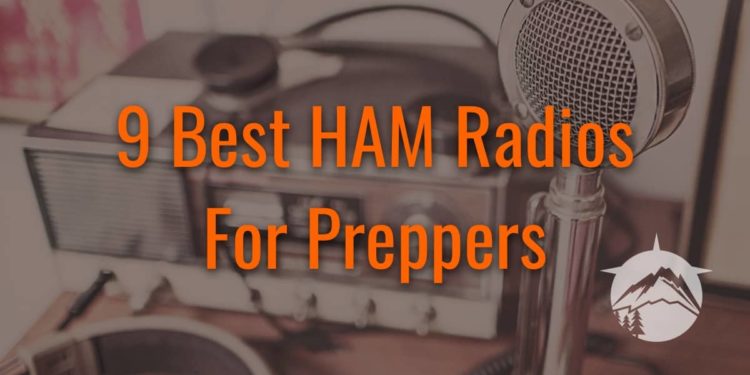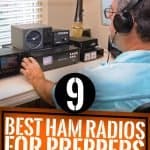READ LATER – DOWNLOAD THIS POST AS PDF >> CLICK HERE

In an emergency, you might not have your cellphone or social media to stay in contact with your loved ones and emergency services.
Depending on the severity of the situation, your conventional means of communication might become useless paperweights. That’s where HAM radios come in.
HAM radios are amateur radios that use the radio frequency spectrum to communicate.
They don’t rely on service providers and complex public networks to communicate with each other.
They’re essentially walkie-talkies on steroids, and they’re a lot more reliable in an emergency.
Users are heavily regulated for a number of reasons, but a licensed HAM radio enthusiast can use their radio as a hobby, emergency communication device, and as a way to listen to emergency information that might not be available via traditional means.
In fact, if you check out my guide to Faraday cages, you can combine a HAM radio with one to have the most reliable communication system possible. Today, I’m going to teach you a little bit about HAM radios by focusing on the emergency uses of HAM radio communication, and I’ll show you some of the best HAM radios you can throw in your survival kit.
Top 9 HAM Radios For Preppers
Licensing Requirements
As I said, HAM radio users are regulated pretty heavily.
You’ll need a license to be able to legally operate one, and there are a few different licenses that you can pursue.
Each type of license covers a different level of HAM radio usage. This is mostly because of the fact that HAM radios can reach beyond our U.S. borders, and it’s important that users conduct themselves in an appropriate manner.
They can also be used for illegal activity, and ensuring that all HAM users are licensed and regulated helps to prevent that from happening.
The Technician License
The Technician’s license is the first license that you’ll have to get to start operating a HAM radio.
It gives you basic privileges, and it allows you to operate your radio on any frequency over 50-MHz.
However, you’ll have limited privileges when it comes to transmitting your voice or using Morse code on below 30-MHz.
This license is best for people who just want to listen to emergency information or communicate casually.
The General License
A General license removes nearly all of the limitations that come with a Technician’s license.
In fact, it allows you to do just about everything besides access a few high-frequency bands.
Obviously, that makes this the license that is most useful for preppers because of how much freedom it gives, but it’s a bit harder to get, and it’s not necessary for basic use.
The Amateur Extra License
The Amateur Extra license is for serious HAM enthusiasts.
It gives you the ability to access every frequency, and it’s the most difficult license to attain.
It’s not really necessary for preppers to attain an Amateur Extra license, but it’s an option if you really enjoy HAM radio.
Handheld VS Mobile VS Base Units
There are three different categories that HAM radios fall into.
Each one is good for a different use, and each one has its own pros and cons.
Handheld
Handheld units are exactly what they sound like.
They look like high-tech walkie-talkies, and they function in a similar way. Handheld HAM radios are typically a lot cheaper than larger units, and they’re convenient for when you may need to communicate while you’re away from home.
However, they’re not perfect for every use. Handheld radios are powered by batteries, and that greatly reduces their power output.
That can make it difficult to communicate over long distances, and that might be necessary in an emergency. They’re also difficult to use in a car.
In order to keep from experiencing a lot of issues such as batteries dying and being distracted, you’ll have to use several aftermarket accessories.
Mobile/Base
Mobile and base units have the same pros and cons.
The only difference between the two is that one is mounted in a vehicle, and the other is made for at-home use. These units have a lot more power output than handheld units, and they’re a lot easier to hear due to their advanced audio systems.
They also broadcast their signal at full power for the duration of the time that they’re on.
You don’t have to worry about batteries. The downside to using a mobile or base unit is that you’ll need an antenna.
Mobile units will typically add an abnormally large antenna to the top of your vehicle, and base units can require towering masses of metal on your roof or in your yard.
So, you obviously have to commit to these units a little more than you do handhelds.
What’s Your Goal?
You can save money and time by understanding what you want a HAM radio for before you buy one.
The licenses get more expensive as you progress, and larger base units require a much larger financial investment. If you just want to listen to emergency broadcasts or contact your licensed family members, you can get by with a handheld radio and a Technician license.
If you want to contact a large variety of people and really delve into HAM radio communication, you’ll need to invest more money and time into it. I personally don’t think you need any more than the basics for survival purposes, but HAM radio is a popular hobby for a reason.
You might end up wanting to go beyond the basics at some point.
If you can’t afford to install a giant antenna and base radio, you shouldn’t try to.
It’s overkill for most survival needs, and it can set you back quite a bit financially. I suggest creating a budget before you buy a radio, and try to stick to that budget when you start shopping.
You don’t need much to properly communicate in a survival situation.
Bands
Different licenses grant you access to different frequencies, and some radios aren’t strong enough to access certain frequencies.
Before you buy a radio, you need to understand what band you’ll need access to for your desired use.
Short-Range Emergency Communication
Short-range communication doesn’t require a lot with HAM radio technology.
A Technician license with let you use any band over 50-MHz, and that’s all you really need for this type of communication.
Home HF Communication
This type of communication will most likely require you to get a General license.
A Technician license gives you access to some high-frequency stations, but you’ll be limited in what you can do with it.
For home HF communication, you’ll want access to UHF and HF bands.
Local/Regional Communication
This is where you’ll start to need an Amateur Extra license to broadcast on higher frequencies.
A General license will do the trick in a lot of cases, though.
Portable Operating
If you’re using a handheld unit, you’ll be able to access UHF and VHF bands on the go.
If you want to access HF bands, you’ll need to install a mobile base unit in your vehicle, and you’ll want to pursue more advanced licenses for unlimited band access.
Buying your first HAM radio
All the information above can be a lot to take in at first.
The video below has some extra information that you can use when you want to buy your first HAM radio.
HAM Radio Reviews
I’ve reviewed the best HAM radios available, and I’ve made those reviews available in the following sections.
They’re divided into the three main categories of HAM radios, and there’s a few options in each category.
Handheld
BAOFENG BF-F8HP (UV-5R 3rd Gen) 8-Watt Dual Band Two-Way Radio

This is an upgraded version of the popular UV-5R 2nd Gen from BaoFeng.
It has a battery that lasts a lot longer than the previous model, and it has a power output rating of 8 watts.
That’s a fairly good amount of power for a handheld, and the battery life makes it more reliable for survival.
However, It’s still a handheld unit, and you shouldn’t expect it to do much more than other handheld units.
I really like the shell on this unit. Communication is key in a survival situation, and a lot of handheld HAM radios are pretty easy to break.
The shell on this one is a lot stronger, and it can handle being banged around quite a bit. It also protects the built-in high-gain antenna.
Pros
- Great shell
- Long battery life
- High-gain antenna
- 8 watts of output
Cons
- Not good for long-distance communication
- Limited band access
WouXun KG-UV9D Plus Two-Way Radio

The WouXun KG-UV9D is a walk-talkie type of radio, and it functions very similarly.
However, it can pick up seven different bands, and it can memorize up to 999 channels.
It also has better speakers than the majority of handheld HAM radios, and it’s programmable if you plug it into your computer.
Pros
- Lot of band access
- Channel memory is high
- Great speakers
- 2000Mah battery for long battery life
Cons
- Shell isn’t as durable
- Very high price

This Kenwood is a really nice radio for people who are serious about getting into HAM radio.
It’s extremely pricey, but it features IF filtering, APRS certification, and it has GPS features.
It can also work well for HAM enthusiasts that have the license necessary for more long-range communication.
However, it’s very pricey, and I only recommend it if you’re very serious about using it.
Pros
- VOX / semi-VOX (requires headset)
- Auto clock
- APRS certified
- Amateur radio compliant
- IF filtering for clear communication
Cons
- It’s very expensive. The features are worth it for more advanced HAM enthusiasts, but beginners should go with a cheaper option.
Mobile

The ICOM IC-A120 packs plenty of power into a small package.
It’s small enough to be moved from your vehicle to your home with ease, and it has 36 watts of power output that doesn’t change with constant use. What I like the most about the IC-A120 is its user-friendly interface.
It doesn’t have any complicated keypads or text-style buttons.
It uses a knob, a few buttons, and a simple digital display.
That limits the functionality of the unit when its compared to more robust units, but it makes it easier for beginners to get the hang of.
Pros
- User-friendly interface
- Low price
- 36 watts
- Small size
Cons
- While it’s good for beginners, the limited functionality might make it less useful for more advanced users.
- Doesn’t cover all bands
TYT MD-9600 GPS Dual Band DMR Mobile Transceiver 50-Watt Car Truck Radio

This is the third generation of TYT HAM radios, and it’s a fairly advanced radio.
It features newly upgraded speakers, keypad lights, and the ability to be programmed via a home computer.
I personally don’t recommend this radio to new users because it’s a little difficult to set up.
If you’re willing to deal with a long setup process, it’s a great radio, and it’ll last for a very long time.
Pros
- Long lifespan
- Advanced radio capabilities
- FCC certified
- Accesses most bands
- Weighs less than 3 pounds
Cons
- The difficult setup process is a bit much for some users
- It’s twice the price of the ICOM, and it doesn’t offer everything you need
BTECH Mobile UV-50X2 50 Watt Dual Band Base, Mobile Radio: VHF, UHF Amateur (Ham)

The BTECH Mobile has a lot of automatic features that make it easier for beginners to use properly.
It’s not the most powerful unit, but it is one of the easiest to use, and I recommend it for beginners.
It can automatically scan for new channels, power off, and set its audio gain settings.
Pros
- Affordable
- User-friendly
- Automatic features make life easy
Cons
- It’s not as powerful as other mobile units. It only has a 50-watt power output. That’s still not bad, though.
Original Yaesu
FT-2980R FT-2980 Original Yaesu

This Yaesu model is built to last.
It features an over-sized heatsink that keeps you from needing to install a cooling fan in your vehicle, and it has all of the features you need for amateur radio.
It’s also the most powerful unit that I’ve reviewed in this category with its massive 80-watt power output.
It’s not able to do everything that the most advanced mobile units can, but it can do enough to keep the majority of HAM operators happy.
Pros
- Large heatsink
- Lots of output
- Large display
- User-friendly keypad
Cons
- It’s the cheapest mobile unit I’ve reviewed, but that also means it doesn’t have a lot of features.
Base
Eton Elite, The Classic AM/FM/LW/VHF/Shortwave Radio with Single Side Band

Out of the two base units that I reviewed, this is the least expensive, and it’s still not cheap.
It costs a little under $400, but it packs a ton of power.
It can pick up every radio wavelength including AM,FM, LW, SW, SSB and VHF aircraft band frequencies; 360° rotating AM antenna pulls in even the weakest signals for full, bold sound.
Pros
- Can pick up nearly any frequency
- Great for shortwave and AM
- IF DSP ability
Cons
- It’s a bit pricey for a beginner unit
- The interface is confusing for a lot of users

The FT-991A can easily satisfy the pickiest of HAM radio users.
It’s basically an upgraded version of the other base unit I reviewed, and it has a price tag that matches its upgraded features.
It features a fully colored display, and it can access any band that you need it to.
Pros
- Great display
- Full access to any band
- 100-watt output
- Upgrades every feature of the previous model
Cons
- I can’t recommend this to new users. It costs nearly $1500, and a lot of the features are aimed at more advanced users. If you have the skills and license necessary to use the more advanced features, it’s great. Otherwise, you need to go with the other option that I reviewed.
Final Thoughts
The Original Yaesu mobile radio that I reviewed is the clear winner among all of these options.
FT-2980R FT-2980 Original Yaesu
Our Top Pick

9.6/10 Our Score
- Large heatsink
- Lots of output
- Large display
- User-friendly keypad
It may not be enough to satisfy more advanced users, but it has plenty of features and power output for preppers to use reliably.
In fact, the more simplistic design of it can make it a lot easier for preppers to use.
I hope that you liked this article, and I hope you’ve learned a little bit about HAM radios.
If you did, I’d love read your comments, and I hope that you share it with your friends.
Also Read: 9 Best Bowie Knives for Survival










